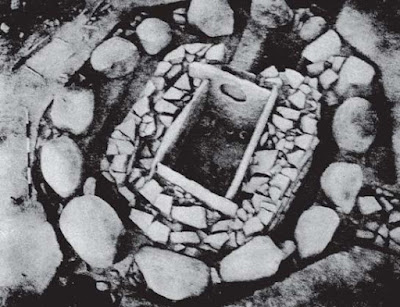The term ''megalithic'' is derived from the Greek words, megas which means huge or big and lithos, i.e stone. But unlike the 'palaeolithic', 'microlithic', 'neolithic', or 'chalcolithic' it does not refers to classes of tools rather 'megalithic' refers to the ritual use of stone as stationary symbols or guardians of a site. In south India, the stones were exclusively associated with burials i.e the stones were erected in the memory of the dead. The Megalith monuments have been found in many parts of the world and in the Indian subcontinent, they occur in far south, the Deccan plateau, the Vindhyan and Aravali ranges, and the north-west.
 |
| Megalithic burial |
The Megalithic monuments reveal a great variation in their forms and structure, yet they represent, in the Indian context, a homogeneous culture dominated by two key elements- a) use of iron tools and weapons and, b) familiarity with a polished and well-fired pottery called Black and Red Ware. The Megalithic cultures provide an important link with between the southern Neolithic- Chalcolithic cultures on the one hand and the Early Historical period, characterized by Satavahana rule in the Deccan and the Sangam literary traditions in Tamil Nadu, on the other.
The structural forms of Megalithic monuments have been classified by Krishnaswami, Allchin and others in different types. A . Sundara has characterised three basic types of megaliths, a) the chamber tombs b) unchambered tombs c) megaliths not connected with burials. The chamber tombs usually consist of a chamber composed of two or four vertical slabs, topped by a horizontal capstone. If the chamber is underground it is known as cist. If it is partially underground it is known as a dolmenoid cist. If it is fully underground it is known as a dolmen. The chambered tombs include the topi-kal / kallu (hat stones) and kudai-kal (umbrella stone) found in Kerala and Karnataka. In topi-kal, the burial urn is placed in an underground pit and is covered by low, convex, circular capstone supported by four upright stones or pillars. Kudai-kal refers to a hood-stone which without any support rests directly on the ground to conceal the burial below it.
 |
| dolmen |
 |
| Menhir |
 |
| kudai-kal |
 |
| Port- hole cist |
 |
| Topi-Kal |
 |
| Urn burial |
 |
| Cairn stone circle |
The unchambered burials are of three types. a) Pit burials (the funerary remains are buried in a pit) consisting of pit circle, cairn stone circle and menhirs. Pit circle is the pit burial marked by a circle of large stone. In cairn stone circle, a pile of stones heaped up in form of circle is used to mark a tomb and a pit burial marked by a single standing stone is known as a menhir. b) Urn burials which consist of funerary remains placed in a large pot or urn and c) Sacrophagus burials consisting of legged urns of pottery, decorated with animal heads, containing human bones.
There are many megaliths which are not connected with burials and consists of large stones aligned in various geometric patterns. The precise function of such megaliths is still not clear.
In 1823, Babington published for the first time an account of the Megalithic tombs in Malabar region of Kerala, ever since then a number of sites have been reported. A maximum number of sites are reported from Karnataka. The prominent Megalithic sites are Adichanallur and Paiyampalli (Tamil Nadu); Porkalam in Kerala; Nagarjunkonda and Yelleswaram in Andhra Pradesh; Naikund, Mahurjhari, Khapa, Talaghat in Maharashtra; Allahabad-Mirzapur-Varanasi region of Uttar Pradesh, Burzahom in Kashmir etc. In Assam and Meghalaya, the Megaliths constitute a part of tradition still living among the natives.
The Megalith peoples beside using Black-and-Red Ware type of pottery and Iron tools and weapons also used gold, silver, copper indicating that the Megalithic artisans were proficient in working out these metals as well. The Megalithic people also used beads of semi-precious stones such as carnelian and agate as ornaments. Their settlements are found mostly located near either a hilly area which could provide stone for their graves, or the mining areas from where they could obtain iron, gold etc for their tools, weapons or ornaments, or a water led region for agricultural activity.
The shreds of evidence though limited suggests that the Megalithic peoples did mixed agro-pastoral activities and their diet included agricultural products as well as hunted animals. An analysis of grave goods has led U.S. Moorti to argue that the Megalithic people of South India had probably a ''ranked society'' dominated by a ''chief'.'' He also adds that the high percentage of adult males in the graves probably suggests a patriarchal nature of the Megalithic society in which males occupied special status. It is also suggested that funerary goods placed systematically along with dead bodies are indicative of people's faith in burial rituals and their beliefs in life after death. It is pointed out that ancestor worship is an important medium to claim and sustain the power of the succeeding chief and, therefore, it is possible that the megalithic graves represent the prevalence of ancestor worship among the people.
REFERENCE:
A History of Ancient and Early Medieval India(From the Stone Age to the 12th Century)f- Upinder Singh
- Prehistory and Protohistory of India-V.K. Jain
- A People's History of India 3: THE VEDIC AGE and the coming of Iron c. 1500-700 BC










Thank you for this good illustrated article. I am using some images for a lecture i am composing on the broad topic of Archaeology of India
ReplyDelete